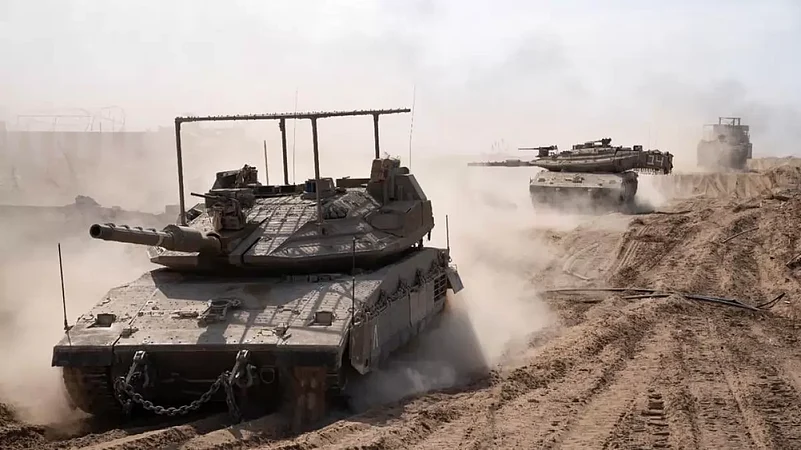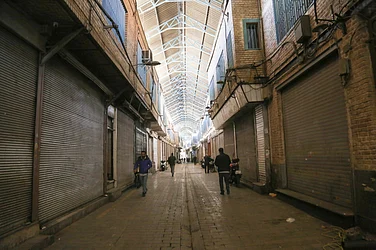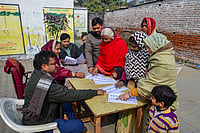The Israeli military on Monday said it has encircled the Gaza City in its ground operation and has effectively divided the Gaza Strip into two northern and southern parts.
The Israeli military is conducted a ground operation in the northern parts, a watered-down version of a full-fledged ground invasion that initially expected. Throughout the operation, Israel has focussed on the northern part and has asked the Palestinian civilians to move southwards to avoid getting caught in the crossfire.
As US Secretary of State Antony Blinken concludes a multi-nation tour of the Middle East, including Israel and Ramallah in West Bank, and presses for greater humanitarian aid to Palestinian civilians in Gaza, Jordan in coordination with Israel airdropped medical supplies in Gaza.
While trucks containing food, medicines, and other relief supplies are entering Gaza through the Rafah crossing on the Gaza-Egypt border on a regular basis, the number is nowhere close to what the United Nations (UN) agencies have sought. While the UN agencies have sought 100-200 trucks a day, Turkish state-run news agency Anadolu Agency reported that 30 trucks crossed in the latest tranche of aid and a total of 451 trucks have crossed over so far.
Blinken has pressed for minimising the civilian loss of life in the ongoing fighting between Israel and Hamas. While the United States has not called for an immediate ceasefire and continues to support Israel in the war against Hamas, a designated terrorist group, it has called for pauses in the fighting and the delivery of more aid to Gaza.
Hamas attacked Israel through air, land, air sea on October 7 and killed at least 1,400, injured over 5,400, and took over 220 as hostages. It also launched around at least 3,000 rockets that day as it went on a rampage across southern Israel, seeking out civilians and attacking them. Israel retaliated by launching airstrikes in Gaza to take down Hamas leaders and facilities. Two weeks back, it also began a ground operation after days of limited ground raids. While a number of Hamas leaders and sites have been brought down, widespread civilian casualties have also been reported in Gaza.
Hamas-run Gazan authorities say that over 10,000, at least 4,000 children, have been killed and over 25,000 have been injured in Israeli airstrikes. Hundreds of thousands of Palestinians have also been displaced in the ongoing fighting in Gaza and lack basic amenities. There is a shortage of food and medicines in the region. Even though Israel has reopened two of the three water pipelines that it closed after the Hamas attack, the widespread displacement and destruction of houses has resulted in a grave humanitarian situation in the territory.
Israeli operation divides Gaza into two parts
By encircling Gaza City, the Israeli military has divided the Gaza Strip into northern and southern parts. The Israeli ground operation is centred in the northern part.
Israeli military spokesperson Rear Adm. Daniel Hagari said, "At this hour, we are carrying out a large attack on terrorist infrastructure both below and above ground. Essentially today there is a northern Gaza and a southern Gaza."
Now that the Israeli military has encircled Gaza City, it is expected to enter the city and pitched urban battles are expected. In the past 24 hours, the Israeli military said it has struck over 450 Hamas targets, including personnel, military compounds, observation posts, and anti-tank missile launch sites.
"IDF ground troops took control of a Hamas military compound—containing observation posts, training areas for Hamas operatives and underground terror tunnels—in Gaza. Based on ISA and IDF intelligence, IDF fighter jets neutralized Jamal Mussa, who was responsible for the special security operations of Hamas," said Israel Defense Forces (IDF) in a statement.
"Israel has described Gaza City, in the north of the enclave, as a center for Hamas’s military operations, and its encirclement of the city appeared aimed at cutting it off from the rest of the strip...Admiral Hagari said that the operation on Sunday night was searching for senior Hamas commanders," reported The New York Times.
Separately, the Israeli military accused Hamas of using two more hospitals for its operations. Earlier, it had said that Hamas uses Gaza's largest hospital Al Shifa as a base for its operation. It said that Hamas's command and control centre exists in tunnels under the hospital. Now, Israel has said that two more hospitals, Sheikh Hamad and Indonesian, are also used by Hamas as a cover.
Even as Israel intensifies its bombardment of Gaza and encircles the Gaza Strip amid urban battles with Hamas and aligned Palestinian groups, Hamas has continued to fire rockets at southern and central Israel for 30 days straight now. In the past 24 hours, rockets have targeted a number of Israeli cities.
From continuous rocket attacks from Gaza and Lebanon, more than 200,000 Israelis have been internally displaced in the country. The Times of Israel reported, "Some 130,000 Israelis have been evacuated, and another 120,000 or so Israelis have voluntarily left the northern and southern border areas where they were subject to attacks by Hamas and Hezbollah."
Jordan airdrops aid in Gaza amid health crises
Amid an ongoing healthcare crisis in Gaza Strip during the monthlong war, Jordan on early Monday dropped medical supplies in the territory.
King Abdullah II of Jordan tweeted that the supplies were for the Jordanian field hospital in Gaza.
"This is our duty to aid our brothers and sisters injured in the war on Gaza. We will always be there for our Palestinian brethren," said Abdullah II.
Axios reported that Jordan and Israel had coordinated for the airdrop. "An Israeli official told Axios the Jordanian air drop was conducted in coordination with Israel's military...The airdrop was necessary due to a delay in transporting aid over land through the Rafah Border Crossing between Egypt and Gaza, according to the Jordanian military," said the report.
The development comes as healthcare situation remains grim in Gaza. The New York Times quoted the World Health Organization (WHO) as saying that 14 hospitals in Gaza, including 10 in the Gaza City, are no longer operational and at least 100 health facilities have come under attack since the beginning of the war.
The healthcare crises has been worsened by the shortage of fuel in the region, which is required to run generators to power the hospitals. While medicines, food, and water has been constantly entering Gaza, though nowhere close to the envisioned 100-200 trucks a day, no fuel has been allowed into Gaza. Axios, however, reported that there is a plan to allow fuel into Gaza in case the situation becomes untenable in the region.
"The Israeli Defense Forces (IDF) chief of staff Lt. Gen. Herzi Halevi said on Thursday that Israel would transfer fuel to hospitals, with monitoring, when needed. But on Friday, Israeli Prime Minister Benjamin Netanyahu said after his meeting with Secretary of State Tony Blinken that Israel won't allow any fuel into Gaza. Nevertheless, Israel's COGAT — the Coordinator of Government Activities in the Territories — is preparing for a way to provide fuel to Gaza if Israel determines it is needed, the sources said," reported Axios.
The report further said that Israeli officials and international aid organisations' experts would calculate how much fuel would be required and then, following the approval from the Israeli War Cabinet, the fuel tankers would enter Gaza from Egypt and would be used under the supervision of a UN team.


























